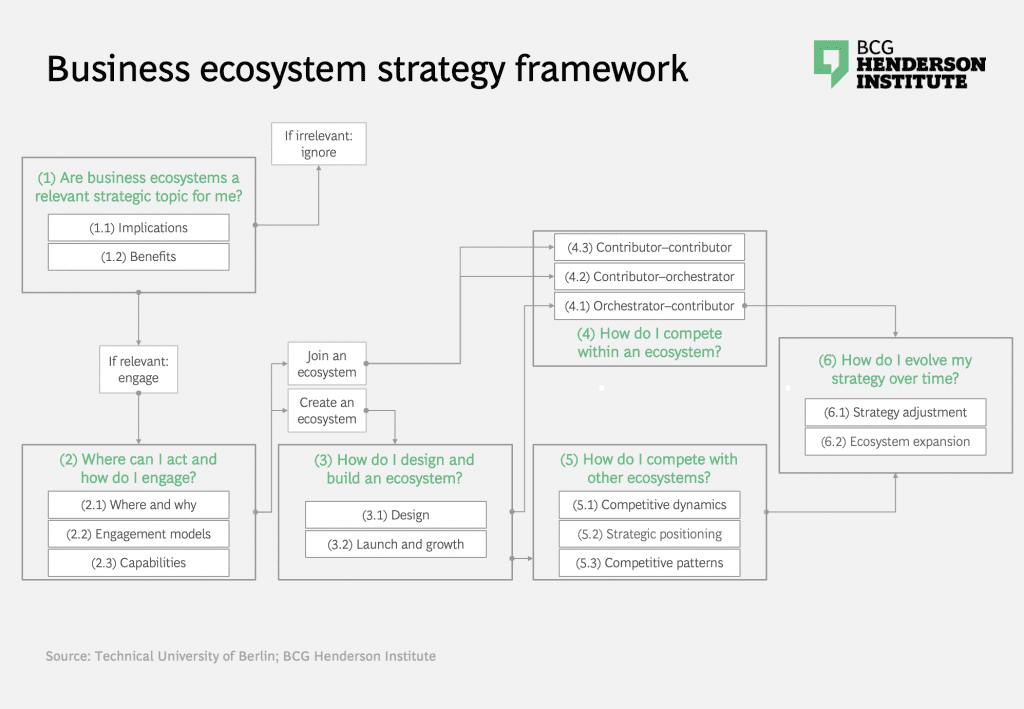From financial services and retail to automotive and mining, no major sector of the economy is untouched by the rise of business ecosystems. These dynamic groups of largely independent economic players, typically collaborating on a digital platform, can address new customer value propositions that individual competitors cannot match. Given the success of many big tech and startup firms with this business model, it’s no surprise that ecosystems are high on the strategic agenda of incumbent companies. More than half of the S&P Global 100 companies are already engaged in one or more ecosystems, and in a recent BCG survey of 206 executives in multinational companies, 90% indicated that their companies planned to expand their activities in this field.
Yet many leaders of incumbent companies are unsure how to define their ecosystem strategies. They realize that traditional principles of business strategy rooted in the concept of competition do not serve them well. But ecosystems pose several new challenges. For example, it is not enough to design the value creation and delivery model; the design must also explicitly consider value distribution among ecosystem members, and this requires a systems perspective. At the same time, ecosystems cannot be entirely planned and designed; they also emerge organically and continuously evolve. This adaptability is one of their major strengths. Rather than just being hypercompetitive, successful ecosystem players develop a novel way to compete: They use collaboration as a source of competitive advantage, which allows them to reduce asset ownership and instead use the resources of others.
What guidance and support can practitioners glean from academic research on business ecosystem strategies? In recent years, we’ve seen explosive growth of ecosystem-related academic publications. However, the field has developed into multiple, largely independent research streams and still lacks a coherent framing and research agenda. Consequently, we embarked on a systematic review of the relevant literature across academic disciplines to distill the key findings, structure them into a holistic ecosystem strategy framework, and derive promising areas for future research. This article provides a short summary of our results; the full study is available here.
Methodology
Our systematic literature review started with a Boolean search on a range of criteria related to business ecosystem strategy in three leading academic online databases. We retrieved a total of 4,053 articles, of which 2,338 remained after excluding duplicates. We screened each article’s title, abstract, and introduction, excluding studies outside of the subject area in each iteration. This process left 437 contributions as a basis for deeper content analysis. We applied a grounded theory approach to identify 151 concepts in a first coding step, successively aggregated these concepts into strategic questions, and arranged them into a logical order of subsequent strategic decision-making stages.
Overview of existing research
Ecosystem strategy research has seen a growth dynamic similar to that of the overall field of business ecosystems. The number of newly published articles has consistently increased in recent years, with more than half of the contributions appearing in the last four years. The literature body is dominated by the field of business (36%), followed by computer science (13%), economics (12%), and decision science (12%). Only about a third of the contributions are empirical studies with an emphasis on technology-based industries, such as information technology, media, and telecommunications. More recent research has expanded into other sectors, such as retail, finance, and industrial goods.
Business ecosystem strategy framework
Based on iterative coding of the identified 437 articles, we derived a process framework of business ecosystem strategy development that structures existing research into six distinct decision steps (see Exhibit).

In the first step, an economic actor must decide to what extent business ecosystems present a relevant strategic opportunity (Q1). Multiple contributions analyze how business ecosystems blur the boundaries among sectors and challenge incumbent firms’ market positions and institutional logic. Organizations that consider engaging in business ecosystems must learn to transform their resources and capabilities and adjust organizational processes. Another stream of research investigates the benefits that firms can gain from business ecosystems, for example, in dealing with uncertainty, fostering innovation, and expanding into new fields.
If a company concludes that ecosystems are relevant, it must identify opportunities and ways to engage (Q2). Few publications provide guidance on how to find promising opportunities; they mainly suggest identifying technological discontinuities, industry convergence, and industry bottlenecks. When an ecosystem opportunity has been identified, the next question is how best to engage. A company can either join an existing ecosystem as a contributor or create and orchestrate its own ecosystem. Assuming the role of orchestrator was found to offer the largest value creation potential, but also requires the highest upfront investment and risk. Some studies indicate that the contributor role can be just as attractive, particularly if multiple ecosystems are supported.
As an orchestrator, a company needs to build and launch its own ecosystem (Q3). Major design decisions investigated in the literature include the exact features of the value proposition, the number of participant groups, the pricing and value appropriation mechanism, and the initial governance model. The challenges of launching an ecosystem have been investigated in multiple studies, and several strategies for increasing the odds and limiting cost and risk have been identified. For example, successful orchestrators were found to initially focus on core users to test the value proposition, stage the development of the platform by adding functionalities over time, subsidize one side of the market to encourage participation, or develop content for the platform themselves instead of waiting for third-party contributors to innovate.
An important theme in the literature is the challenge of balancing different interests within an ecosystem. The participants of an ecosystem collaborate and compete at the same time, which requires distinct strategies (Q4). The orchestrator receives the largest share of attention. Several studies analyze how orchestrators can capture the value created by the ecosystem, for example, through pricing strategies and by entering the product spaces of successful complementors. Other studies demonstrate how aggressive orchestrator behavior can lead to lost contributor support, disintermediation, and increased multihoming.
The within-ecosystem strategies of contributors have received less attention in the literature. Existing studies suggest that contributors should monitor exploitative behavior of the orchestrator, such as the risk of the orchestrator extending into their product space, and decrease their dependency on individual orchestrators. However, exclusive relationships were also found to augment a contributor’s position and increase potential profit appropriation.
The largest research stream by far in the existing literature deals with the question of how to successfully compete with other ecosystems (Q5). Many contributions investigate the specific dynamics of between-ecosystem competition, which is characterized by the importance of network effects and the resulting potential for winner-takes-all dynamics. Three sources of differentiation and competitive advantage have been identified: (1) ecosystem scope (which market segments to target and whether to aim for a mass market solution or focus on smaller niche segments), (2) customer value proposition (whether to aim for a broad and varied product offering or focus on a highly curated targeted offering), and (3) partner value proposition (various strategies to attract contributors to the ecosystem and retain them). The partner value proposition is a new and idiosyncratic element of an ecosystem strategy, and early findings point to the importance of an ecosystem’s governance model as a source of competitive advantage.
Finally, the orchestrator must adjust its ecosystem strategy over time and identify opportunities for ecosystem expansion (Q6). Few studies have addressed this challenge. Some have identified changing strategic patterns along the life cycle of an ecosystem, moving from an open strategy and governance model in the early and uncertain stages toward more dominating and rigid models once the ecosystem matures and uncertainty declines. Other contributions recognize the potential and challenges of international and cross-sector ecosystem expansion, but don’t further explore the strategic success factors.
Future research directions
Our review has shown that previous academic research strongly focused on between-ecosystem competition (Q5), within-ecosystem competition (Q4), and ecosystem design (Q3). We have also identified substantial gaps in the literature that should be addressed by future research. For example, scholars could help practitioners to better understand which skills are required to discover and exploit ecosystem opportunities and how incumbent firms can successfully transform into ecosystem players.
In particular, strategies for ecosystem contributors could be investigated more deeply. We know little about the relative attractiveness of orchestrator versus contributor roles and about the different strategic choices that firms have to succeed as contributors to business ecosystems. Finally, as ecosystems mature, they increasingly face the challenge of expanding beyond their initial domain. We need to better understand the strategic options for ecosystem evolution and how ecosystem strategy fits into the broader corporate strategy of diversified firms.
Further reading
If you want to explore more deeply some of the topics in this literature review, we recommend our series of publications on ecosystem design, governance, and strategy as further reading:



